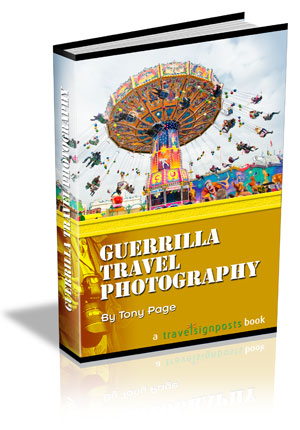As soon as you get off the train and set eyes on Venice’s Grand Canal, that’s where the fun can begin, but while it’s romantic, beautiful and a photographer’s paradise, Venice can at times be a hard place to photograph. It is one of the most visited cities in the world and yet you can have a frustrating time trying to capture its beauty. That is why when I came across, Tony Page’s two fantastic PDF guides on Travel Photography, I knew I had to share this with all my Rookies out there.
Guerilla Travel Photography (130 pages) is full of practical tips relating to the preparation (before take-off, packing and security tips), photography basics (terminology and functionalities), and actual shooting (divided by the subject: people, landscapes, cities, interiors and night shots). It even tells you how to make the best of rainy day shooting!
Take Better Digital Photos (135 pages) had more of a breakdown on various shots and effects to use with digital cameras that I had never thought of, and he breaks it down in a quick and easy tutorial on how to immediately improve your digital images by using simple creative tools and techniques. There are over 130 color pictures to explain the photography effects and advice he gives. For example, look out for S-curves in the frame shot, look out for opposing elements in shots, or how to use “Depth of Field”.
Tony Page of TravelSignPosts.com has over thirty years’ worth of travel and photography experience, which makes him a true expert in both fields and his extensive blog posts, pictures and books prove it. Guerilla Travel Photography and Take Better Digital Photos, together will make any novice photographer instantly seem semi-professional in a matter of hours. I learned a lot from these two books and while they can apply to any city in the world, I thought I’d go into how it applies to photography in Venice. These books also give amazing photography tips for travelers who want to pack light but don’t know what equipment to bring, security tips to avoid losing data or your equipment, and how to take awesome pictures of even the most photographed landmarks. One of my favorite tips was regarding those annoying rules of leaving your camera behind in certain museums. Basically, Tony suggests, if you can’t take the camera with you, take your memory cards out of the camera and put them in your pocket. Might seem logical, but how many of you really remember to do that? He has many more cool tricks that can save you time and money.
The Down Low on Venice Photography (based on lessons learned from Tony Page’s Guerilla Travel Photography Ebook):
When to Go
As a photographer the best time to go is the Spring or Autumn (April/May and late September through to late October). The reasons for this are that it is less crowded, cooler and the light is less harsh than mid-summer. Hotels on the historic island can get expensive but off peak you may find hotel deals.
How to Get Around
Water buses are the very best way to see Venice itself and the network covers the whole of the lagoon. Tony also suggests that in new cities, this method or hop-on, hop-off buses are a great way to scout the city for the best sites to later photograph. Budget-wise it is best to buy a multi-day vaporetto pass which will enable you to travel on any waterbus at any time during its validity. Just remember to validate your pass every single time you ride the waterbus or you can incur a penalty.
What to Shoot in Venice
Perhaps the most iconic location in Venice is St. Mark’s Square, and in my opinion there is only one time to shoot it – early. Plan on getting to the square about 45 minutes before sunrise. At this time the square is deserted and as the sun rises, the light is truly magical. The waterfront by St. Marks is a great place to shoot Venetian life before the tourists arrive, waiters setting up their tables, elderly Italian’s sitting in the sun reading the morning newspaper and the unmanned gondolas make fantastic foregrounds to the cityscape shots. From sunrise you will have about 90 minutes of good shooting time before the crowds arrive.
As the crowds do arrive, it is worth a walk to the nearby Arsenal, the very photogenic old fort of the city, largely ignored by tourists. A bridge crosses the canal in front of the grand entrance and makes a great viewpoint for shooting from.
By now, the heat of the day will be kicking in and the light can get a little harsh. Shooting-wise, now is the best time to wander the alleys and backstreets. It is here that you will find fantastic little details such as Venetian masks in shop windows, the play of light and shadows amongst the winding alleys, or quirky stuff on buildings such as lion shaped door knockers. Be careful with your exposure here as the contrast between the shadows and the highlights can be very high. Lastly, so many of the buildings feature multiple arches and these can make great frames for a wider shot.
Venice is so full of details that you can spend many hours just photographing them. Now I am starting to see Venice with a photographer’s eye and you can too!
Buona Fotografia!




